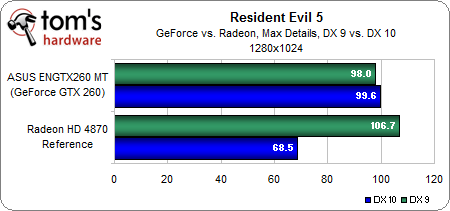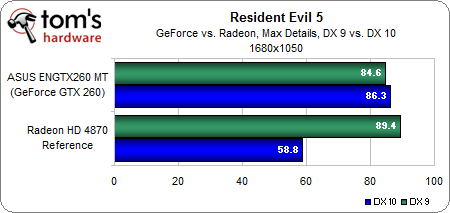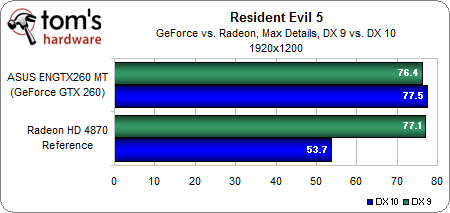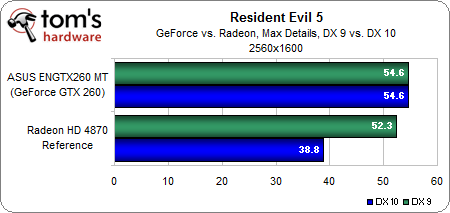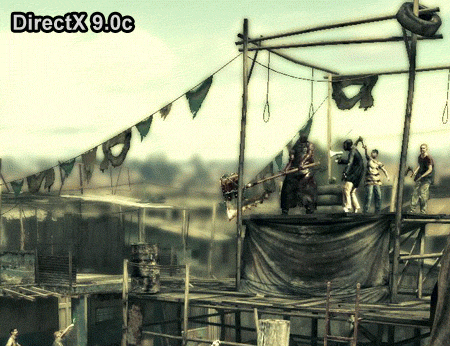Resident Evil 5: Demo Performance Analyzed
Image Quality: DirectX 9 Versus DirectX 10
Let's have a closer look at performance differences between the DirectX 9 and DirectX 10 render paths using a GeForce GTX 260 and a Radeon HD 4870:
The Radeon HD 4870 is able to match the GeForce GTX 260's performance using the DirectX 9 render path, but when the DirectX 10 render path is used, the Radeon is crippled and the GeForce keeps on truckin'.
What exactly is DirectX 10 doing that is eating up all of those processing resources on the Radeons and not on the GeForce cards? Let's look at some image comparisons to see what's going on:
As far as we can tell, not a heck of a lot. This is unexpected because of the substantial performance hit that the DirectX 10 render path imposes on Radeon cards, which is very strange and puzzling.
Intrigued by these results, we asked a Capcom representative to connect us with the game's programmers to find out exactly what kind of extra processing was going on under DirectX 10, and what we should look for in order to qualify it. It took the firm a little while to get an answer for us due to some translation issues, but it responded with the following note:
"Sorry, but the response from the team is not very exciting: simple answer for both, [no] new content, or shaders, [or] effects added to Direct[X] 10.
Benefits for the DirectX 10 users: nothing special, no enhancement.
Get Tom's Hardware's best news and in-depth reviews, straight to your inbox.
I can tell you that Nvidia's GeForce 3D Vision LCD glasses require DX10, so there's a definite need to be on Vista in order to see the incredible 3D effects in action."
This explains a lot, actually: we're not seeing any difference between the DirectX 9 and 10 screenshots because there's no difference to see.
With this in mind, there's certainly no reason for anyone to play this game in DirectX 10 mode, except for GeForce owners who are using Nvidia's GeForce 3D Vision LCD glasses.
Current page: Image Quality: DirectX 9 Versus DirectX 10
Prev Page Image Quality: Radeon Versus GeForce + 3D Vision Next Page Test System And SettingsDon Woligroski was a former senior hardware editor for Tom's Hardware. He has covered a wide range of PC hardware topics, including CPUs, GPUs, system building, and emerging technologies.
-
gkay09 Does this imply that game developers in general dint even utilize the full potential of DirectX 9 and jumped on DirextX 10 bandwagon and now to DirextX 11?Reply -
renz496 i've tried the benchmark before. the dx 10 produce slightly better frame rate than dx9. this game have better performance in dx 10 compared to dx 9 in my machineReply -
yellosnowman Am I going blind or is there no HD4890Reply
or is this just a quick benchmark before the HD5*** series -
mitch074 @yellosnowman: there is a 4890, but it's been downclocked to 4870 levels (read the article) to be used as reference for Radeon performances (tests on Radeon wasn't too extensive, as the benchmark is optimized for Nvidia hardware). And yes, with HD 5xxx almost there, doing complete benchmarks here is pretty much useless: the game is playable with everything at full on a Radeon HD 4770 up to Full HD quality.Reply -
voltagetoe Gkay09, Direct X 10 was a failure because Vista was a failure. DX 9 has been thoroughly utilized - there has been no other choice.Reply -
juliom On the variable benchmark @ 1680 x 1050 2x AA my Phenom II x4 955 and Radeon 4870 pulls and average of 80 fps in directx 9. I'm happy and have the game pre-ordered on Steam :)Reply -
amnotanoobie voltagetoeGkay09, Direct X 10 was a failure because Vista was a failure. DX 9 has been thoroughly utilized - there has been no other choice.Wasn't it more of because the mainstream DX10 cards (8600GT and 2600XT) didn't really perform well, and even some were beaten by previous generation cards. As such, pushing the detail level higher might mean fewer sales as fewer people had the cards to play the games at decent levels (8800GTS 320MB/640MB or 2900XT).Reply -
HTDuro DX10 isnt really a failure .. if programmer take time to really work on DX10 optimisation .. more on SM4.0. remember Assassins creed? ubisoft take time to work on SM4.0 and the game work better in D10 than 9 ... higher framerate with better shadowReply
